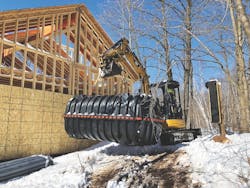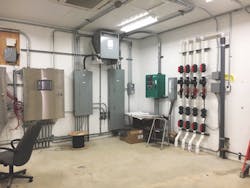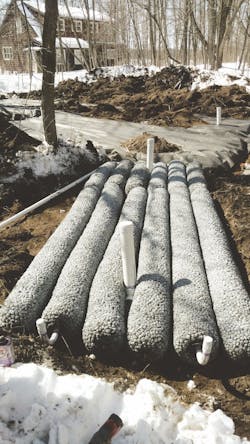Across the Ice
About the author:
Allison Blodig is engineered systems specialist for Infiltrator Water Technologies. Blodig can be reached at [email protected].
Aerobic treatment units (ATUs) offer a suitable environment for microorganisms to treat wastewater. These pre-engineered advanced wastewater treatment systems are alternatives for small system designs with space restrictions and limited room for conventional treatment or where centralized sewerage is not available. ATUs are applied on sites with poor soils, shallow vertical separation distances to limiting conditions, and horizontal setback restrictions. Some systems can be designed for the treatment of high strength wastewater or where total nitrogen removal is required.
Understanding Aerobic Treatment Units
Mechanically induced aeration is engineered to produce a residual oxygen concentration of at least 2 mg/L or 2 ppm along with mixing within the unit. The oxygen and mixing processes support microorganisms as they break down the organic portion of the waste. In addition, mechanisms are used to keep solids out of the effluent and keep bacteria in the treatment process. The resulting effluent produced from an ATU is higher quality than from a septic tank in terms of total suspended solids (TSS), biological oxygen demand (BOD), and in some instances, ammonia (NH3) and total nitrogen (TN).
Whether in a residential or commercial system, the system choice and design are key to the longevity and sustainability of the ATU. In addition, having a good site plan, installation guidance, a plan for educating the customer, and a strategy for operation and maintenance (O&M) are important.
In most cases, regulations will dictate what treatment levels need to be achieved and for what purpose. For a single-family home, certified systems typically are applied using the appropriate model number of the ATU for the flow and treatment level required, but in larger or commercial systems it is important to choose a proven system for the specific application. Providing the system location as well as influent flow (i.e., volume and schedule) and strength to system manufacturers is necessary for them to provide a proper treatment plan for the application.
The geographical location is important because temperature and altitude can have big effects on the system and must be considered. It also is important to understand what resources are available for operation and maintenance in the area, as this will make a difference in the type of technology chosen and some design elements that may go into the system. Sludge management is critical to proper functioning, so a remote location may require additional sludge holding or treatment to be on the site.
Aerobic Treatment Design Tips
Here are six tips for choosing and designing a system for aerobic treatment.
1. Choose a proven system for the application and system size. Ask the manufacturer for successful case studies and data. For single-family homes, double check the flow and treatment level dictated by regulation so the appropriate model number of the ATU is chosen. For systems that are expected to achieve high effluent BOD, TSS and/or TN removal, be sure to reference the influent flow and strength to select the best system for your application.
2. Review commercial and large ATU system influent constituents, as they can differ from ANSI/NSF standards. Provide all information to the system manufacturer you choose. This will enable them to recommend an effective treatment plan for the application. Recognize that the system may require a treatment train that includes multi-stage treatment processes.
3. Incorporate flow equalization for systems with sporadic flow or strict effluent requirements. Check local regulations to determine if flow equalization is required on every system. Ask the system manufacturer if the application or effluent requirements would benefit from having flow equalization added to the design. Understand potential treatment issues in commercial applications, such as a church where the system is only used a couple of days a week.
4. Consider the effect temperature can have on the system. Burial depth and blower placement are important at any temperature. Cold temperatures can cause a loss of treatment, especially with nitrification. Hot temperatures can influence sludge settling and impede proper microbial growth.
5. Determine what chemicals and medications are used at the site. Discuss system operation with the owner and operator, including restrictions on chemical use such as cleaning fluids and sanitizers with the active ingredient quaternary ammonia. Explain to the owner or operator how medications can affect the system. Antibiotics and pharmaceuticals can be used in homes, but may pose a problem in places like nursing homes, assisted living facilities, doctors’ offices, and critical care facilities. Obtain more information about what chemicals are found in certain products and at certain facilities.
6. Implement O&M access into the design. Specify the use of a trained operator. Provide training on system mechanics, specifications, and location of buried components. Specify sludge measurement and removal as part of O&M.
Aerobic Treatment Project Profile
Farm Island, Minn., sits in Farm Island Lake north of Minneapolis, where most installation work stops during the winter. When Septic Check of Milaca, Minn., was contracted to design and install a new onsite system for a 1,400-sq-ft, year-round recreational dwelling on the island, it waited for winter to enable transporting project materials across the frozen lake to the remote island site.
An ATU system was the ideal choice for this installation because Minnesota regulations require a minimum separation of 3 ft between a conventional system drainfield and the water table. By choosing an ATU and including an ultraviolet (UV) lamp, the required separation was reduced to 1 ft. The wastewater treatment system is 250 ft from the lakeshore. Wastewater exits the house via 12 ft of PVC pipe to the first of three Infiltrator IM-1060 1,000-gal tanks, where settling and anaerobic treatment occurs.
Wastewater then flows by gravity into the second tank, where a Delta Ecopod E50 ATU provides aerobic processing. It leaves the Ecopod and flows by gravity through a Salcor UV light to the last tank, then is pumped 65 ft through a 2-in. pipe to the absorption field. The 585-sq-ft absorption field uses 200 ln ft of EZflow geosynthetic aggregate divided into three beds fed by a manifold of 2-in. pipe. Varying bed sizes maximized the small patch of good soil available on the 1-acre lot. The system is controlled by a Delta Treatment Systems control panel.
Septic Check used a snowplow truck to create a 3,400-ft-long road across the ice to the island. Equipment and supplies were driven across the frozen lake on a trailer and technicians commuted by snowmobile. An auger regularly bored holes to check the thickness and quality of the ice for safety. To prevent the soil from freezing prior to the early March installation, the site was covered with frost blankets the previous fall. Additionally, clearing all dirt piles prevented overnight freezing each day.
Remote locations and site restrictions are ideal for using ATU treatment systems. The flexibility and ease of use make these systems an integral part of the wastewater infrastructure. When aerobic treatment is designed properly, and installed and operated correctly, the system will provide quality treatment for years to come.



